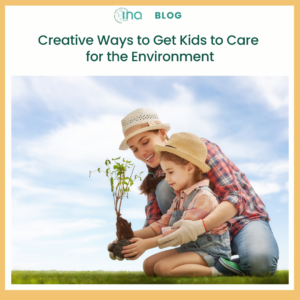 By Ellen D. McNeal
By Ellen D. McNeal
As a parent, you have many responsibilities to ensure your kids are healthy and developing properly, such as planning their meals and arranging their education through a private tutor or custom paper writing service, so it’s easy to forget to teach them how to take care of the environment. But it’s actually pretty easy. You can accomplish this by:
Turn Recycling Into a Family Task
Create a game out of recycling by naming it the Recycling Race. Then, assign each child a bin labeled with terms such as paper, plastic, or metal and observe which child can organize the items the most efficiently. Recycling can be rendered engaging and enjoyable by establishing a timer and awarding a modest reward to the victorious participant.
Make Trash Pickup Playful
Educate your children against leaving rubbish all around. Remind them that waste may be dangerous to animals and often finds its way into locations it shouldn’t, including the ocean. You can also bring garbage bags when you visit the park or beach next time and have a one-minute race to see how many bits of trash your youngster can gather.
Watch the trash attentively to ensure that it is safe and not sharp or irritating. Upon completion, ensure that you have a hand disinfectant to ensure a thorough germ and dirt removal.
Instruct Young Ones On The Importance Of Conservation
This is a simple and fun thing that kids can learn. It’s even possible to start very early before the child is even in preschool. Start with easy habits like encouraging them to use a reusable water bottle or to recycle paper and cardboard. The best part is that you can give them a special treat, like their favorite cake, on the weekend if they do it without being told.
Share Stories About Global Warming
Your young ones might ask questions about the changing climate. In fact, many are either personally experiencing or learning about climate-related catastrophes such as heat waves and floods. Remember, everyone is affected by climate change.
If they are at an age where you believe they can learn about complex issues like global warming or the effects of greenhouse gases, then don’t hesitate to dive right in. But don’t make it scary. The trick is to use stories to impart crucial knowledge while making the lessons about climate change memorable without freaking them out.
Be an Example
Most children copy their parents or elders. That’s why such phrases as “When I grow up, I want to be like my dad” or “I want to be just like my big sister” are common. This is the reason why you have to take the first step if you need your kids to have a special interest in environmental issues or know more about them.
You can choose which environmental issue you want to address, for instance, air pollution or global warming. Then, just start with reducing your family’s dependence on fossil fuels. For instance, consider using reusable water bottles and coffee cups when trying to minimize waste. The less complicated the strategy, the easier it will be to implement.
Another brilliant method of being a role model is through the replacement of school or office supplies, entertainment, or household items with eco-friendly alternatives. For example, one can convert disposable bags to cloth shopping bags. This can also help reduce the carbon footprint and transportation expenses when you decide to buy local products. Seek out local eco-friendly shops and farms. Don’t forget to support small businesses that will boost the economy and create jobs.
Teach Them That Nature Needs Protection
Take walks to demonstrate how weather affects the environment. Explain how various weather patterns influence seasons and use plants to illustrate how different levels of heat and precipitation change their flowering times. You may also want to talk about different species, including where they live, thus emphasizing the necessity of preserving those areas.
Enjoy Nature With Your Kids
Concentrating on outside activities is usually more successful than directly talking about environmental issues while kids are younger and before they start school. Spending time as a family hiking, visiting playgrounds, or going to the beach teaches them to value the wonders of the earth. The most crucial lesson is ultimately teaching young ones that the environment is worth protecting.
You could also get them involved in planting flowers, trees, fruits, or vegetables in your yard or planters. Show them how plants grow and let them help care for and water them. This is a great way for them to learn and enjoy the beauty of nature.
Talk About Environmental Issues as They Come Up
As parents, we can’t know everything about environmental issues or nature. But that doesn’t mean you shouldn’t answer questions raised by your kids, especially when they pertain to the environment. In this case, Google is your friend and can impart general knowledge or basics that will make it easier to talk about a specific environmental issue in general.
Finally, don’t forget to show your kids that people can be part of the solution. To do that, use examples of popular celebrities who have shown they care about the environment and what they have done so far. They could have donated huge sums of money to protect endangered species or been actively involved in activities such as beach cleaning or charities that focus specifically on saving the environment.
Actively Involve Them in Activities That Contribute to Solving a Problem
You might be surprised to learn that young ones are increasingly aware of environmental changes and are eager to make a difference. Easy home initiatives and school involvement like tree planting are effective ways to involve them in the fight against climate change. Include children in starting a compost bin for kitchen scraps and garden waste or creating wildlife habitat. They can help set up the bin, learn about composting, and turn the compost regularly.
This teaches them about reducing waste and recycling organic material into valuable soil. When you get children involved in designing and building a birdhouse or a butterfly garden, allow them to help select the materials, plant the right flowers, and set up the habitat. That way, they learn about supporting local wildlife and the importance of creating safe spaces for wildlife.
